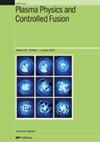System size scaling of triangularity effects on global temperature gradient-driven gyrokinetic simulations
IF 2.3
2区 物理与天体物理
Q2 PHYSICS, FLUIDS & PLASMAS
引用次数: 0
Abstract
In this work, we explore the triangularity effects on turbulent transport employing global gyrokinetic simulations performed with the ORB5 code. Numerous experiments on the Tokamak á Configuration Variable (TCV) and, more recently, on the DIII-D machine, have demonstrated superior confinement properties in L-mode of negative triangularity (NT) over positive triangularity (PT) configuration. This presents a particularly attractive scenario, as L-mode operation eliminates or significantly mitigates the presence of hazardous edge-localized modes (ELMs). However, a full theoretical understanding of all these observations remains elusive. Specifically, questions remain about how NT improvements can extend to the core where triangularity is very small, and whether these improvements can scale to larger devices. This paper addresses these two questions. Our analysis is divided into two parts: we first demonstrate that the confinement enhancement in NT configurations arises from the interdependent edge-core dynamics, and then we present the results of a system size scan. Crucially, we find that the relative turbulent transport reduction of NT over PT appears not to be contingent on machine dimensions or fluctuation scales and is moreover robust with respect to variations in plasma profiles. This insight underscores the fundamental nature of the NT confinement advantage and paves the way for its potential application in future fusion devices, regardless of their size.全球温度梯度驱动的陀螺动力学模拟中三角效应的系统规模缩放
在这项工作中,我们利用 ORB5 代码进行了全局陀螺动力学模拟,探索了三角形对湍流传输的影响。托卡马克可变配置(TCV)以及最近在 DIII-D 机器上进行的大量实验证明,负三角形(NT)L 模式比正三角形(PT)配置具有更优越的约束特性。这提出了一个特别有吸引力的方案,因为 L 模式运行消除或显著减轻了危险的边缘定位模式(ELM)的存在。然而,对所有这些观测结果的全面理论理解仍然遥遥无期。具体来说,NT 改进如何扩展到三角形很小的内核,以及这些改进能否扩展到更大的器件,这些问题仍然存在。本文将探讨这两个问题。我们的分析分为两个部分:首先,我们证明了 NT 配置中的约束增强源于相互依赖的边核动力学;然后,我们展示了系统尺寸扫描的结果。重要的是,我们发现与 PT 相比,NT 的湍流传输相对减少似乎并不取决于机器尺寸或波动尺度,而且对于等离子体剖面的变化也是稳健的。这一洞察力强调了 NT 限制优势的基本性质,并为其在未来核聚变装置中的潜在应用铺平了道路,无论这些装置的大小如何。
本文章由计算机程序翻译,如有差异,请以英文原文为准。
求助全文
约1分钟内获得全文
求助全文
来源期刊

Plasma Physics and Controlled Fusion
物理-物理:核物理
CiteScore
4.50
自引率
13.60%
发文量
224
审稿时长
4.5 months
期刊介绍:
Plasma Physics and Controlled Fusion covers all aspects of the physics of hot, highly ionised plasmas. This includes results of current experimental and theoretical research on all aspects of the physics of high-temperature plasmas and of controlled nuclear fusion, including the basic phenomena in highly-ionised gases in the laboratory, in the ionosphere and in space, in magnetic-confinement and inertial-confinement fusion as well as related diagnostic methods.
Papers with a technological emphasis, for example in such topics as plasma control, fusion technology and diagnostics, are welcomed when the plasma physics is an integral part of the paper or when the technology is unique to plasma applications or new to the field of plasma physics. Papers on dusty plasma physics are welcome when there is a clear relevance to fusion.
 求助内容:
求助内容: 应助结果提醒方式:
应助结果提醒方式:


